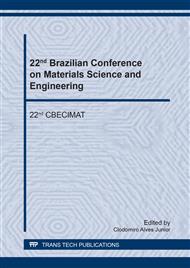p.101
p.107
p.115
p.120
p.125
p.131
p.137
p.142
p.148
Iron Ore Tailing as Addition to Partial Replacement of Portland Cement
Abstract:
The manufacture of Portland cement used in the production of concrete emits large amounts of CO2 into the atmosphere, contributing to the increase of the greenhouse effect. The environmental impact generated by the mineral exploration activity is a problem of easy verification, especially in open pit mines. The present work evaluated the possibility of using iron ore tailing as an addition to the partial replacement of the cement in mortars. The iron ore tailings were processed by drying in oven (48h at 105oC) and milling in a planetary mill (10min at 300RPM), obtaining medium grain size of 14,13 μm. For the characterization, laser granulometry, X-ray diffraction (XRD), scanning electron microscopy (SEM) and differential thermal and thermogravimetric analysis (DTA / TGA) were performed. The sample is composed predominantly by quartz, hematite, goethite and gibbsite. After the characterization, the waste was used in the preparation of test specimens, with 10, 20 and 30% weight substitution of the cement. The composites were submitted to compression tests, with ages of 3, 7 and 28 days, using a strength rate of 0,25MPa/s. The mortars with 10, 20 and 30% of substitution presented resistance of 41.65, 36.26 and 31.64 MPa, being able to be characterized as category of Portland cement of resistance 40, 32 and 25 respectively. Considering the reduction of cement in the mortars produced, the results of compressive strength were relevant for the substitutions. The cements produced with the substitutions according to the Brazilian standards under the mechanical aspect can be classified as Portland cement.
Info:
Periodical:
Pages:
125-130
Citation:
Online since:
September 2018
Price:
Сopyright:
© 2018 Trans Tech Publications Ltd. All Rights Reserved
Share:
Citation:


